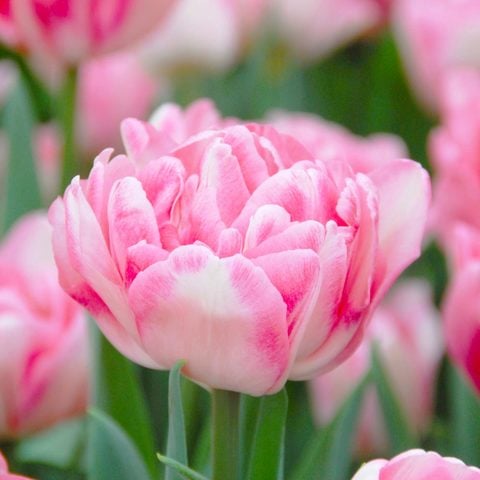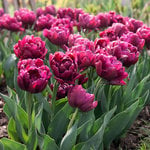Tulip Care
Tulips are indispensable bulbs that have been enjoyed in gardens around the world for centuries. Today, they are available in many shapes, sizes, and seasons of bloom and the smart gardener can have Tulips blooming from early spring through May in a multitude of colors. For the best display, avoid the "soldier effect" and plant the bulbs in clusters. Plant large bulbs 5–6″ apart and smaller bulbs 2–3″ apart. Small Species Tulips are ideal for rock gardens and the tall, large-flowered varieties can hold their own anywhere.
Bulb size: 12 cm /species 5-10 cm
How to Grow Tulips
Most gardeners treat Tulips as annuals. Many Tulips (the midseason and late-flowering varieties in particular) tend to bloom magnificently the first spring or two after planting and decline thereafter. Species Tulips, Darwin Hybrids, Fosterianas, Greigiis, Kaufmannianas, and WFF Perennial Tulips can put on a stunning display for several years with your help:
- Plant at the depth recommended on the plant label (or slightly deeper); we recommend you plant large bulbs 8–10″ deep, smaller bulbs and species Tulips 5–6″ deep.
- Remove blooms (on all but the species Tulips) as soon as they fade to prevent the formation of seeds.
- Allow the leaves to yellow before removing them.
- Fertilize in fall and early spring with any of our fertilizers specifically formulated for bulbs.
- Tulips will also perform more reliably if they are not watered during their summer dormancy.
Most early and midseason Tulip varieties are excellent for forcing—which involves 'tricking' them to bloom indoors before spring. Keep in mind that this rooting process takes 14-16 weeks, so plan accordingly. Please see our forcing bulbs page for more information.
Please note: An amber gel-like substance called gummosis is sometimes present on Tulip bulbs. It is not harmful and will not affect the bulbs' performance.
Light/Watering: Tulips perform best in full sun in the North and will tolerate very light shade in hotter areas. Unless the season is unnaturally dry, normal rainfall should suffice.
Fertilizer/Soil and pH: Tulip bulbs require a well-drained soil. Sandy soil enriched with organic matter is ideal as is a pH of 6.0 to 6.5.
Prechilling & Storage: Keep Tulip bulbs cool (below 65°) until ready to plant.
In parts of the country where winters are mild, Tulips may not receive enough natural cold to stimulate proper growth and flowering. Check with your local USDA Cooperative Extension Service to find out whether any bulbs require prechilling before planting in your area. Place the bulbs in a refrigerator, away from fruits and vegetables (these produce ethylene gas, which can harm the embryonic flowers inside the bulbs). Make sure the bulbs remain dry. The usual prechilling time is ten weeks or longer at 40 to 45°F. Once the bulbs are removed from cold treatment, plant them right away. Bloom occurs about six to eight weeks after planting. Discard the entire plant after bloom.
Pests/Diseases: Aphids may be a problem, but are easily washed off with a water spray. If you notice spindly stems and white or yellowish mottling or streaking of the foliage suspect a virus and dig up and destroy the bulb.
Companion Plants: Tulips are lovely with other spring bloomers and with each other. Mertensia virginica is a sweet companion and Tulips are perfect planted beneath ground covers like Epimedium or Vinca. Underplant Tulips with Forget-Me-Nots for a classic combination.
Pruning: Direct energy to the Tulip bulb by removing spent blooms and developing seed capsules.
Calendar of Care for Tulips
Early spring: Fertilize bulbs now with a suitable formulation.
Mid-Spring: Enjoy the show and cut flowers for gorgeous bouquets. Watch for aphids and wash off if present.
Summer: Deadhead Tulip plants to remove developing seed capsules. Do not water Tulip beds, as most varieties prefer to stay dry in summer, and keep beds weeded. Do not remove foliage until it has yellowed completely.
Fall: Plant new bulbs at least a month before the ground freezes and water in. Check pH and adjust to 6.0 to 6.5. Fertilize established plantings now.
Frequently Asked Questions
When to plant Tulip bulbs?
Plant Tulips well into fall, when nights start getting cooler, a month or so before the ground freezes. Cold temperatures and moisture in the soil will spur development of roots, which must occur before bulbs enter their required winter chilling period.
How to plant Tulip bulbs?
As noted above, plant large bulbs 8-10" deep; plant species and smaller bulbs 5-6" deep. We offer a Bulb Planter to ease the process, if desired.
What are the different types of Tulips?
We've gathered together photos and information about different types of Tulips here.
Where do Tulips grow best?
Tulips require full sun and well-drained soil and grow best in soil with a pH of 6.0-6.5. Raised beds, sandy soil amended with organic material and slopes offer an advantage when it comes to drainage, while heavy clay or poorly drained soil can cause bulbs to rot.
Showy hybrid Tulips grow well in loose, moderately fertile garden soil. Small “wild” species Tulips, sometimes referred to as “botanical Tulips” do well in rock gardens, which mimic the dry rocky mountain slopes in temperate climates where they originated.
Can I grow Tulips in pots?
Yes. Growing Tulips in pots is a great way to create bright accents or take advantage of a sunny spot on deck, steps or terrace. You can start moveable pots of bulbs out of sight, place them to create a colorful display as they come into bloom and then whisk plants away when they’re past their prime - or fill a large fixed planter and enjoy watching them develop.
Choose a winter-proof container with a drainage hole. The container should be deep enough to accommodate your Tulip’s suggested planting depth and leave room for root growth. The pot should be in scale with the plant’s mature height and at least 18-24” in diameter.
Fill the container ½ to 2/3 full of good quality fresh potting soil mixed with sharp sand to improve drainage (not garden soil) and firm soil lightly in place by hand. Tulip bulbs have everything they need to grow and bloom in one neat package, so fertilizer is not necessary.
Arrange bulbs pointed side up, flat bases in good contact with the soil. Plant bulbs in containers closer than you would in the garden, almost but not quite touching. Notice that one side of the bulb is more rounded than the other. Place bulbs with the flatter side facing outward, so the large leaf inside will drape gracefully outward over the side of the pot as it grows.
Cover bulbs with remaining soil to about an inch from the top of the pot (to allow for watering) and water until you see water running out the drainage hole. Containers can be overwintered in an unheated garage or shed, or bury them in wood chips or straw in a place where they will remain cold and the sun will not hit them. If overwintering in an unheated building, check occasionally and water lightly if soil is dry.
Once roots form, freezing is not as much of a concern as repeated freeze/thaw cycles. In containers too big to move, leave several inches of soil around the edge for insulation. You may want to cover pots with hardware cloth to deter hungry mice or voles.
After your Tulips bloom, let them die back and tip them out of the pot. Plant them in the garden or discard spent bulbs and soil.Is there an easy way to plant Tulip bulbs?
Small bulbs can be tucked into the garden with a narrow trowel. Larger bulbs need to be planted deeper. To plant a grouping, dig a hole with a shovel to the proper depth for your bulbs, setting aside soil. Loosen soil at the bottom of the hole to accommodate root growth, arrange bulbs at the recommended spacing and replace soil.
To plant a large number of large bulbs, it’s worth investing in a sturdy long-handled step-on bulb planter. In soft, rock-free soil, a bulb-planting auger attached to a drill is effective.
How far apart to plant Tulips?
Spacing depends on the size of the plant. The smallest wild-type Tulips like Tulipa turkestanica and T. sylvestris are fine to plant as close as 2-3.” Plant medium and large hybrids spaced 5-6” apart. The plant tag or catalog description should specify spacing.
What to do if my Tulip flowers are frozen?
If your Tulips are blooming outdoors and frost or snow causes them to lean over, the best thing you can do is avoid touching them. Simply let the plants thaw out naturally. Handling the plants while they are frozen can cause the plant cells to rupture. Tulips may recover from a brief freeze, but they may not rebound if their cells have been damaged.
Planting Tulips at White Flower Farm
Planting Tulips with Forget-Me-Nots
Shop All Tulips






